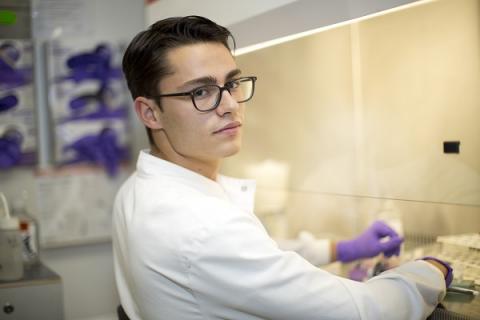As every single patient undergoes their stem cell transplant, they have two questions that they wish they had the answers for: 'Will my transplant be a success?' and 'Am I going to get any side effects?' Although it is not possible to answer these questions definitively, we are getting better at predicting patient responses more accurately.
A new study published in The Journal of Clinical Investigation Insight has developed a test called the MAGIC (Mount Sinai Acute GvHD International Consortium) test. It looks at the expression of certain 'biomarkers' to identify patients who are at a higher risk of developing complications following their transplant, and should therefore be given certain medical treatments earlier.
What are biomarkers?
A biomarker is anything that can be measured to determine a biological 'state'. Most frequently they're proteins, but they can also be fats, sugars or other molecules. They can be used to see if somebody has a disease but also to predict outcomes, such as how they might react to a type of treatment. Ideally, they're tested in body fluids such as blood so that they can be monitored quickly and easily over a period of time from samples taken during doctor or hospital visits.
It is very unusual that one biomarker can be used to accurately predict how all patients will respond to a complex medical procedure such as a stem cell transplant. This means that often lots of different biomarkers are tested all at the same time. The results are then combined to get a more accurate answer.
What has been done with biomarkers?
The scientists looked at blood samples that were taken from over 1,200 patients, seven days after they had their stem cell transplants. They looked at the concentration of four different biomarker proteins that had all been shown to be associated with Graft Vs Host Disease (GvHD) in other studies.
Using two of these biomarkers (called ST2, Reg3α) they were able to identify a high-risk group of patients that were more likely to develop GvHD complications. The low-risk group also had an improved survival rate, six months after their transplant. The findings were then validated by looking at two more sets of patients from different hospitals and transplant centres, and similar groups of high-risk patients were seen.
What will happen next?
It is encouraging that similar results have been reported in a recent publication in the journal Blood. This study also used ST2, alongside other biomarkers, to predict patient survival after their transplant. Although the result of the MAGIC test is promising because it was validated using samples from multiple sites, it still needs to be applied to a higher number of patient samples. This will help to ensure it is accurate and robust for large-scale use. However, the findings can now be used to improve future clinical trial design.
What does this mean for stem cell transplant patients?
Being able to identify at risk patients is only beneficial if we can identify a treatment plan that is of increased benefit as well. This biomarker information can now be used to design new clinical trials where higher-risk patients receive either:
- Earlier treatment to help prevent the onset of GvHD
- More aggressive treatment at the first sign of GvHD developing
If these new treatment plans can be shown to benefit these patients they can then be brought into clinical practice for all high-risk patients.
